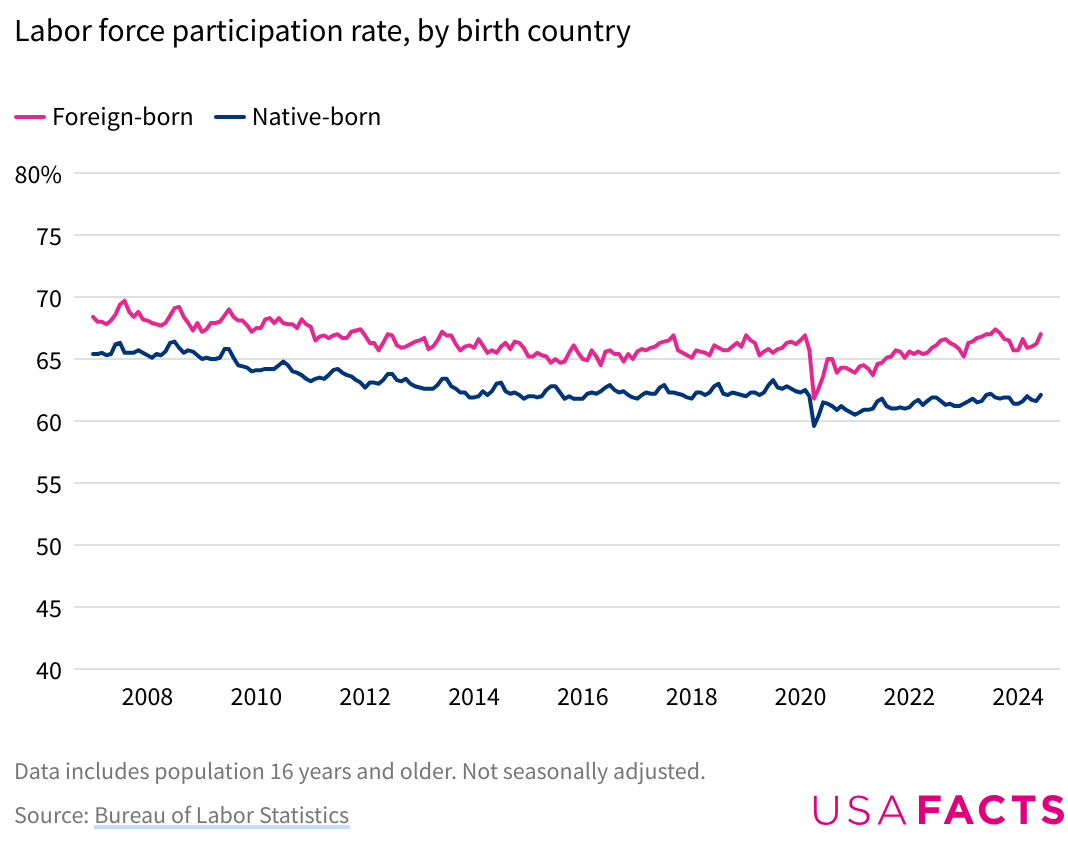In the United States today, there are still more open jobs than unemployed workers to fill them. Even if every single unemployed person were hired tomorrow, 1.2 million positions would remain vacant.
That might sound daunting—but it’s progress. Just a year ago, that shortfall would have been closer to 3 million.
The labor market has made strides in the talent shortage, but the reality is far from stable. While recruiting workers is easier today than it was during the height of the worker shortage, the underlying challenges remain stubborn. For employers, the big question isn’t just about filling jobs today—it’s about navigating the turbulent forces shaping the workforce of tomorrow.
The story behind these numbers reveals deeper, long-term pressures that aren’t going away anytime soon:
1. America’s population growth has slowed, driven by low birthrates and an aging demographic.

2. The share of prime working-age adults—those between 25 and 50—is shrinking, putting a strain on the labor pool.

3. Immigrant Workers Face An Uncertain Future

Immigrants make up about 14% of the U.S. population. Though a minority, this demographic represents a significant portion of the labor force, accounting for one in five workers. Notably, immigrants are more likely to be active participants in the workforce than native-born Americans. Looming immigration policy changes are poised to reduce the number of immigrants working in the U.S., which could worsen the labor shortage.
What A Fluctuating Labor Market Means for Employers
These are all long-term issues that employers will inevitably have to contend with over the coming decades. For now, the U.S. labor force seems to be finding its footing. But how long will that last? Economists warn that much of the recent progress might be short-lived, a temporary blip in a labor market that is fundamentally shifting. The next decade could be marked by waves of unpredictability, where the availability of workers rises and falls in response to economic, demographic, and political forces.
The implications for employers are clear—and unsettling. The days of abundant, predictable labor may be over, replaced by a future where finding the right workers feels a little like chasing a moving target. The question isn’t if employers will face challenges in hiring—it’s how they’ll adapt when they do. Those who wait for certainty may find themselves left behind, struggling to fill roles in a world where talent has become the most elusive resource of all.
The shifting labor landscape is a wake-up call for employers. To remain competitive in the face of uncertainty, businesses must embrace new strategies to attract, retain, and develop talent. The old playbook for workforce management won’t cut it anymore—adaptability is the key to success.
Navigating this complex, evolving environment can be overwhelming. Having a staffing agency that understands these changes and can offer expert guidance is becoming an increasingly valuable resource for employers.
Understanding Labor Market Conditions
In today’s ever-changing labor market, agility is essential for business success. This means continuously evaluating hiring needs and refining recruitment strategies to stay aligned with shifting conditions. Proactive planning is critical—anticipating market changes and building a talent strategy that ensures quick access to skilled candidates allows your organization to navigate uncertainty with confidence.
Equally important is retaining the talent you already have. In high-inflation environments, for instance, regularly reviewing local pay benchmarks is crucial for staying competitive. Additionally, fostering a diverse workforce by understanding demographic trends and attracting younger talent helps ensure long-term stability and growth.
Ultimately, the key to thriving in fluctuating times lies in staying informed and adaptable. By understanding the dynamics at play and positioning your teams strategically, you can set your company up for success, no matter the challenges ahead.
Scenario Planning: Preparing for Workforce Uncertainty
Savvy employers take a proactive approach, planning for potential challenges before they arise. Scenario planning empowers businesses to anticipate a variety of workforce conditions—whether it’s a labor surplus, a talent shortage, or rapid shifts in skills demand—and craft strategies tailored to their specific location and market conditions. By preparing for these fluctuations, companies position themselves to respond swiftly and strategically. This level of foresight can be the deciding factor between thriving in a competitive, ever-changing market and struggling to keep up.
Proactive Partnerships: Strengthening Workforce Development
No company can tackle workforce challenges alone. Building partnerships with community colleges, trade schools, and workforce development organizations is an effective way to create a steady pipeline of talent. Staffing agencies can act as a bridge, connecting employers with these resources and helping to shape training programs that meet specific business needs. These collaborations not only help employers access skilled candidates but also invest in the long-term success of their industry and community.
By embracing these strategies and working with a staffing agency that understands the nuances of the evolving labor market, employers can turn uncertainty into opportunity. The future of work may be unpredictable, but businesses that adapt quickly, invest in their people and leverage expert guidance will be well-positioned to thrive.
Discover how to stay competitive and attract the talent you need.
The labor market is evolving, and so are the challenges for employers. Even with every unemployed person hired, 1.2 million jobs in the U.S. would still be unfilled. While this is an improvement from previous years, it’s clear that navigating today’s workforce demands more than a one-size-fits-all approach.
Factors like demographic shifts, immigration policy changes, and evolving worker expectations mean employers must rethink how they attract and retain talent. The good news? With the right tools and insights, these challenges become opportunities to build a stronger, more adaptable workforce.

